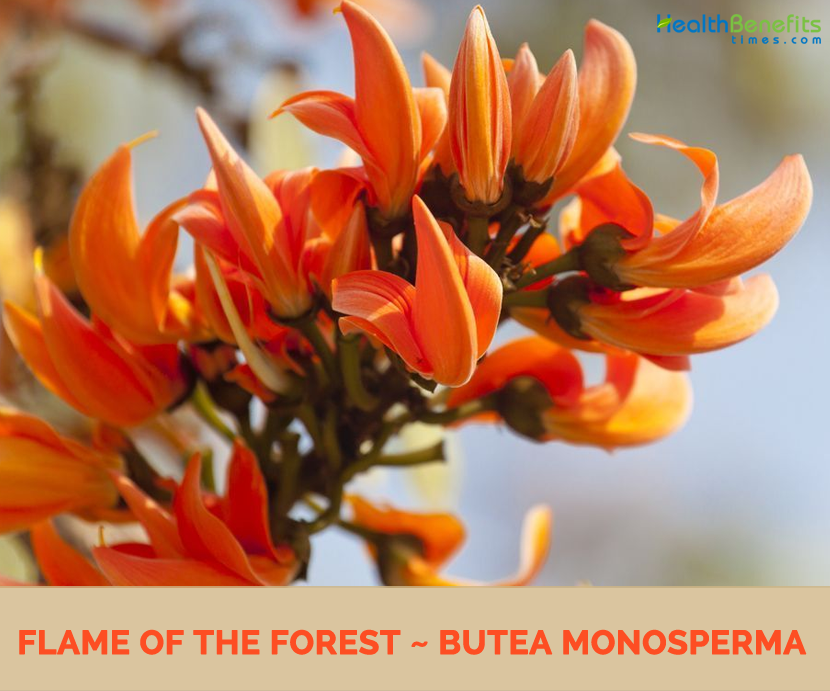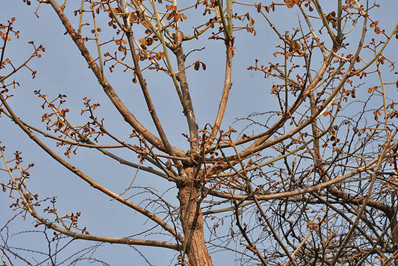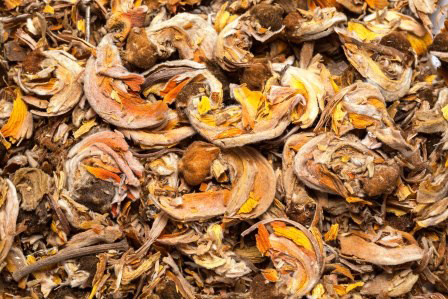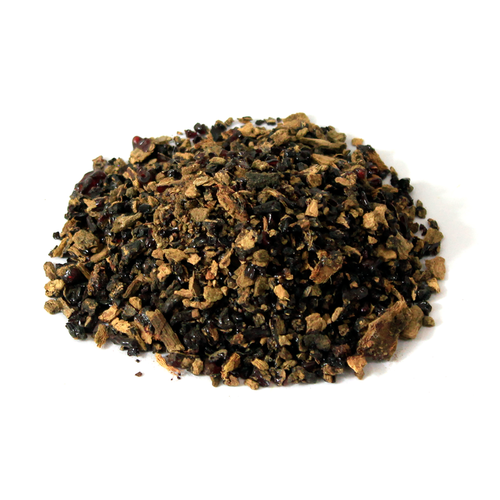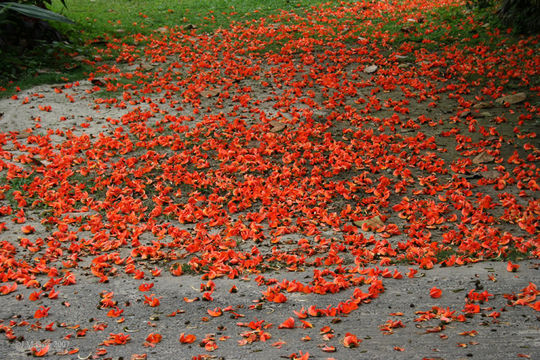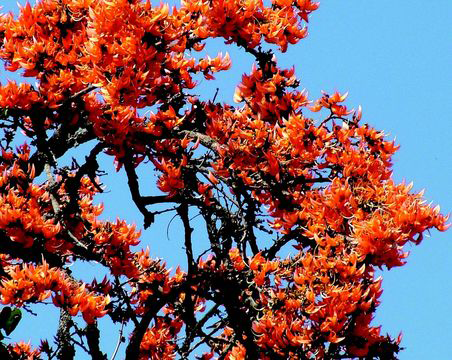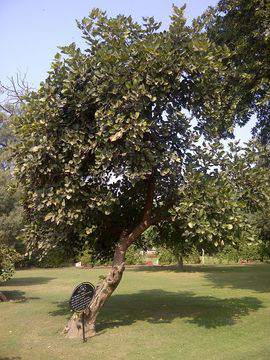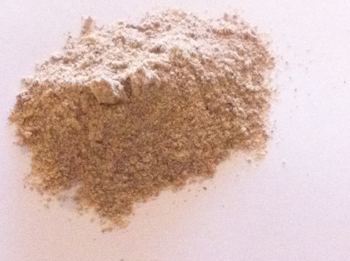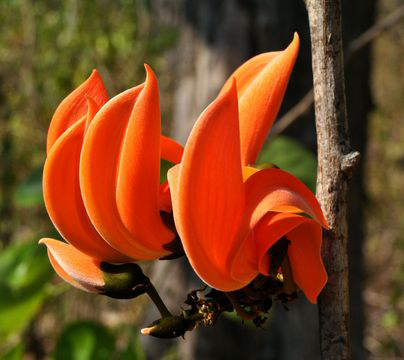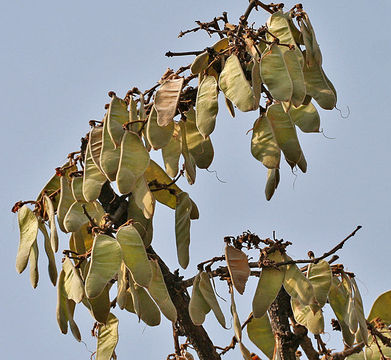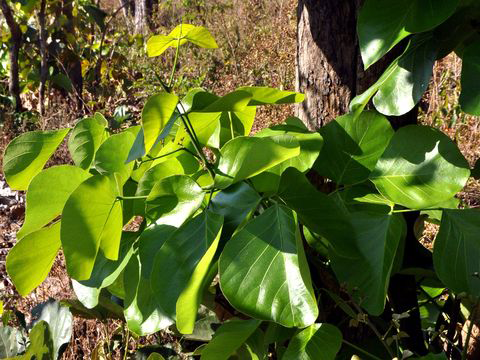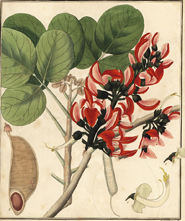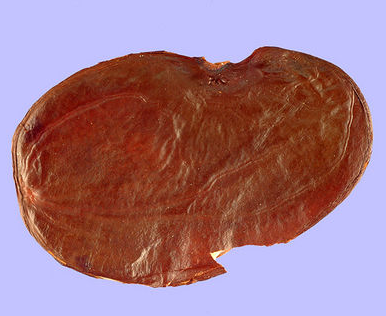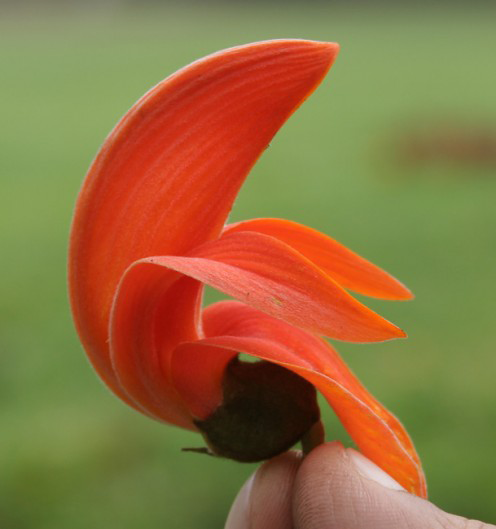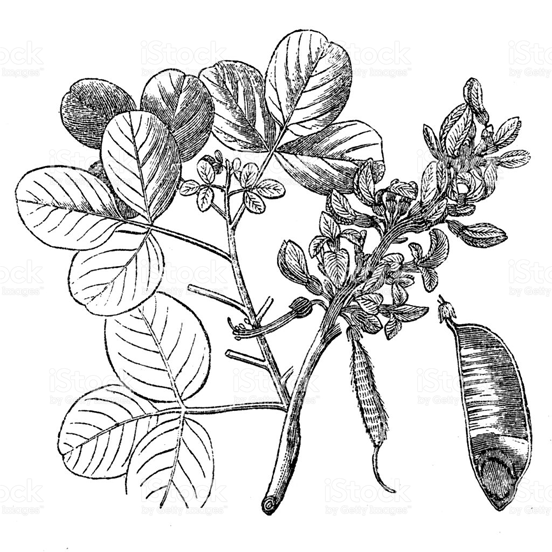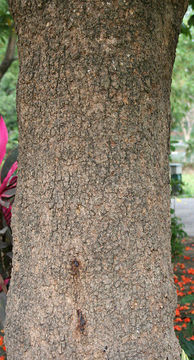Plant Description
Flame of the Forest is a medium sized dry season-deciduous tree growing to 15 m tall. It is actually a slow growing tree; young trees normally have a growth rate of a few feet per year. The plant is found growing throughout the drier parts of India, often gregarious in forests, open grasslands and wastelands. The plants grows on very wide variety of soils including shallow, gravelly sites, black cotton soil, clay loam and even saline or waterlogged soils. Seedlings thrive best on a rich loamy soil. Bark of the tree is fibrous, crooked and twisting and bluish grey or dark brown from outside. Bark of this tree show a reddish exudate. Wood is greenish white in color, soft and weighs about 14 to 15 kg per cubic foot.
Leaves
Leaves are trifoliate with petiole 7.5-20 cm long with small stipules. Leaflets are more or less leathery, lateral ones obliquely ovate, terminal one rhomboid-obovate, 12-27 x 10-26 cm, obtuse, rounded or emarginate at apex, rounded to cuneate at base, with 7-8 pairs of lateral veins, stipellate. Leaflets are obtuse, glabrous above finely silky and conspicuously reticulate, veined beneath.
Flower
Flowers are large in a rigid raceme of 5-40 cm long, 3 flowers together form a tumid nodes of the dark olive-green velvety rachis. Corolla of flowers are orange or salmon colored, keel semi-circular, beaked, veined 3.8-5cm long, clothed outside with silky and silvery hairs. Calyx is about 13 mm long, dark olive-green, densely velvety outside, and clothed with silky hairs within: teeth short, the 2 upper connate, the 3 lower equal, deltoid. These flowers start appearing in February and stay on nearly up to the end of April. The size is nearly 2 to 4 cm in diameter. These tend to be densely crowded on leaflet branches. The flowers on the upper portion of the tree form the appearance of a flame from a distance.
Fruit
Fruit an indehiscent pod, 15–20 cm (5.9–7.9 in) long and 4–5 cm (1.6–2.0 in) broad, stalked, covered with short brown hairs, pale yellowish-brown or grey when ripe, in the lower part flat, with a single seed near the apex. Seed is flat about 25 to 40 mm long, 15 to 25 mm wide, and 1.5 to 2 mm thick. The seed-coat is reddish -brown in color, glossy, and wrinkled, and encloses two large, leafy yellowish cotyledons. Flowering season of this tree is from February to April and fruits appear from month of May to July. Gum obtained from this tree is called gum kino.
Traditional uses and benefits of Flame of the Forest
- Gum improves fertility in men.
- Palash flower are recommended for controlling excessive mensuration bleeding.
- Seeds are useful in the treatment of worm infestations and allergic skin conditions.
- Decoction of the Palash bark is used to wash vaginal discharges.
- It is useful in treating Anorexia, Celiac, Sprue, fever and Hemorrhoids.
- Paste of its seeds is used to treat skin disorders, Edema and eye diseases.
- Oil of Palash seeds is useful in treating Rheumatism.
- Flowers of this tree are antiseptic in nature.
- Flowers are useful in curing Dyspepsia and diarrhea.
- Flowers are helpful in Dysuria.
- Palash flowers are also helpful in protecting age related bone diseases such as osteoporosis.
- Leaves of Palash are used to reduce pain and swelling.
- Root paste when applied under the ear is beneficial for goiter.
- 4-5 drops of Distilled liquid extracted from fresh root along with betel leaf works as an appetizer.
- 30-40 ml leaf decoction is beneficial for stomach disorder.
- 1 tsp of seed powder helps to kills worms inside the stomach.
- 1 spoon seed decoction along with 1 tsp goat’s milk when consumed 3 times a day is beneficial for diarrhea.
- 9 gram of powder of buds along with jaggery is beneficial for urinary diseases.
- Paste prepared from seeds and lemon juice is beneficial for daadh and other skin disorders.
- 4-5 drops of Juice obtained from root when applied inside nose is beneficial for Mirgi attacks.
- 200 g herbal paste prepared from flower when taken with 400 g rock sugar and milk is beneficial for bleeding disorders.
- Herbal paste of seeds when applied over swelling is beneficial for swelling.
Ayurvedic Remedies with Flame of the Forest
- Cure Cataracts in Eyes: Collect flowers of Butea Monosperma and extract juice. Add Indian Beech seeds and let them soak for 48 hours. Then remove the seeds and make their paste with water. Apply this dilute paste to eyes (like kajal) and cataract will disappear.
- Melting Kidney Stones: Make a soup with Butea Monosperma flowers in water by adding sugar. Having 100 ml of this soup twice a day will remove burning sensation in urination and also melt stones in kidney. Same soup can be used without sugar cures all liver related problems.
- Cure Diabetes: Collect Butea Monosperma flowers and dry them. On day 1, soak 1 flower in a cup of water all night and in the morning, squeeze its juice into water and drink that water. From day 2 till day 5, increase the flower count daily. On day 6, start decreasing the flower count (it should be 4 flowers on day 6) and continue till 9th day (it will be 1 flower on day 9). Repeat this cycle for 45 days and keep checking your blood sugar levels every 9th day. You will notice huge drop in sugar level before 45th day.
- Swellings: Warm up some fresh flowers by hot water steam by placing them on a wire rack placed over boiling water. When the flowers are warm enough tie them over any swelling on the body. It is so effective that it removes swelling of arthritis, injury, sprains or due to any other reason, in a day. Dry flowers can also be used if fresh flowers are unavailable.
- Sexual disorders Like Impotency: Powder the dry flowers. Add candy sugar or mishri to the powder and take twice a day about 3 grams of this mixture with milk, morning and evening. It cures impotency.
- Infections of the Stomach/Intestine, Wounds, and Ulcers: Consuming the powdered flowers is also beneficial for these conditions.
- Diabetes & Leucorrhea: Take a mixture of 1.5 grams each of powdered flowers and candy sugar every morning. Those with diabetes should not add sugar.
- Body Heat & Chronic Fever: Crush flowers in milk, add sugar and drink 3 to 4 spoons per day for a month.
- Leucorrhea: Make infusion of the flowers by soaking them in water overnight. Drink 1 cup every morning. Continue till cured.
- Ringworms: Seeds are made into a paste and applied externally with lemon juice to cure ringworm and for cooling effect.
- Urinary Complaints and Urinary Stones: Crush seeds in milk and take 2 tsp of this mixture orally. It relieves these problems.
- Cure Sore Throat: Take few leaves of Butea Monosperma and prepare its extract by crushing it. Now mix leaf extract into the glass of water and gargle with it to get relief from the sore throat instantly.
- Irregular Bleeding during Menses: Drink 3 to 4 tsp of leaf extract at night for 2 to 3 months.
- Snake Bite: 1 tsp of root powder mixed with water when drunk acts as an antidote.
- Eye Disorders: Decoction of the root is used to take care of night blindness, other eye defects and to check elephantiasis.
- Skin Diseases: The decoction of the flowers is used to cure leprosy in the early stages, and for gout and skin diseases.
- Detoxification: Prepare powder of Butea flowers and consume 1-2 grams of powder daily with water. It is bitter in taste but work as very sweet detoxifier to improve your overall health.
- Infections of stomach: If you are suffering from any kind of stomach problems such as internal wounds, ulcers etc., then consume 2-3 grams of powdered palash flowers daily to cure all problems of stomach and intestine.
- Cure vaginal discharge: Mix candy sugar and powder of dried palash flowers and consume 1.5 grams mixture with milk or water to get relief from the Leucorrhea or vaginal discharge.
- Treat Cracks in Feet: Take palash gum and apply it on cracked heels for overnight period to get baby soft feet.
- Cure diarrhea and dysentery: Consume 3 decigrams to 2 grams of palash gum to treat diarrhea and dysentery. Or you can also chew fresh leaves to treat diarrhea and dysentery.
- Increase memory power: Daily consume 2-3 leaves of Butea to sharpen your memory power.
- Urine retention: Flowers (one handful) are boiled in one liter water. The mix is filtered and rock salt is added. This should be taken frequently.
- Cough: Boil a small piece of bark of flame of the forest in water. Drink this water frequently.
- Swelling: Put a bark piece of flame of the forest in boiling water. Drink this water whenever feel thirsty.
- Headache: Make a decoction of flame of the forest bark. Use this water to drink whenever thirsty.
- Dipsia: Make an infusion of flame of the forest’s bark. Add some sugar in it before drinking.
- Ringworm: Sprinkle the seed powder of flame of the forest plant over the affected area.
- Stomach upset: Soak leaves of flame of the forest in the mud pot. Drink this water whenever feel thirsty.
- Testicular Swelling: Crush the flowers of flame of the forest plant. Boil them. Bandage them over Scrotum.
- Aphthous Ulcers: Mix gum powder of flame of the forest in water. Apply this water on the mouth or throat ulcers using a cotton bud.
- Urine Retention: Tie the warm leaves of flame of the forest from lower abdomen to excite the pubic area. OR Make a decoction of flame of the forest flowers. Filter it. Drink whenever feels thirsty by adding some salt in it.
- Abscess: Make leaves paste of flame of the forest. Apply it on the affected parts. OR Bandage the boils with steamed flowers of flame of the forest.
- Leucorrhea: For vaginal discharge or any other infection in the genital areas, take bastard teak powder with milk on an empty stomach. Take for 4 days. OR Boil the bastard teak leaves and wash the genitals with that decoction.
- Dhobie Itch: Crush Seeds of Flame of the forest. Add lime juice in it to make paste. Apply it over the affected areas.
- Dysentery: Sun-dry the gum of bastard teak. Powder the gum. Add quarter tsp of powdered gum with quarter tsp of Cinnamon. Take the mixture with lukewarm water.
- Snake Bite: Grind the barks of flame of the forest and ginger by taking them in equal proportion with water. Apply it on the affected areas.
- Ascaris: Prepare a mixture by adding Azadirachta indica oil with castor oil. Take half tsp of it in the morning with an empty stomach.
Benefits of different parts of Flame of the Forest
As per Ayurveda, the tree balances Vata and Pitta. It has been used extensively in Ayurvedic, Unani and Homeopathic medicine. Extracts of various parts of the tree as well as the whole parts possess anti-microbial, anti-bacterial, anti-fungal, hypoglycemic, anti-inflammatory, astringent, tonic, aphrodisiac and diuretic properties.
Leaves
Leaves have astringent, carminative, anthelmintic, aphrodisiacal, tonic, anti-inflammatory, anti-diabetic, wound healing properties. Hot poultice of leaves relieves boils, pimples, skin ulcers, swelling and bleeding piles. Juice of leaves can be used as an enema. Decoction of the leaves treats leucorrhea and diabetes. They can be put into a douche to treat leucorrhea. The leaves are good for eye diseases.
Flowers
Flowers have astringent, anti-diarrheal, anti-cancer, hepato protective, anti-oxidative, expectorant, diuretic, anti-inflammatory, anti-gonorrheal, tonic, aphrodisiacal and emenagogue properties. They are also depurative, remove swelling and promote menstrual flow, prevent pus formation in urogenital tract of males. Extracts of flowers have free radical scavenging activity. They also have strong chemo protective effect.
Seeds
Seeds have anthelmintic activity. Seeds treat diarrhea, when ground and mixed with lemon juice, and applied, they can relieve itching of ringworm and eczema. Crushed seeds have the potency to kill maggots in wounds and sores. Fruit and seeds are useful in piles, eye diseases, inflammation. They cure skin diseases, abdominal troubles and tumors.
Bark
Bark is acrid and bitter and has appetizing, aphrodisiacal, laxative, anthelmintic, properties. It is useful in bone fractures, piles, hydrocele, liver disorders, gonorrhea, dysmenorrhea, biliousness and purifies blood. It cures diarrhea, dysentery, sore throat, ulcers, and tumors and neutralizes snake bite poison. A paste of the stem bark relieves body swelling. Stem juice benefits if applied on goiter.
Roots
Roots possess anti-fertility, aphrodisiacal and analgesic properties. They are useful in night blindness, filariasis, helminthiasis, piles, ulcers and tumors. They cure night blindness and other eye defects.
Gum
Gum is astringent to the bowels. It relieves stomatitis, cough, excessive perspiration and corneal opacitiy. The gum is used for treating diarrhea and dysentery. A decoction or infusion of the gum is used as enema.
Other Facts
- Flowers are offered to the local deity, Bommappan.
- Bark yields a dye.
- Roots are made into paint brushes by the local people.
- Bark yields good fiber.
- Leaves are much used for plates as wrappers and as fodder for buffaloes.
- Red kino gum is extracted from the trunk.
- Bark is used in herbal preparations.
- Flowers are specially used in the worship of Lord Shiva on occasion of Shivratri in Telangana.
- In most of the old namboodiri (Kerala Brahmin) houses, one can find this tree because this is widely used for their fire ritual.
- It is used for timber, resin, fodder, medicine, and dye.
- Wood is dirty white and soft and, being durable under water, is used for well-curbs and water scoops.
- Good charcoal can be obtained from it.
- Leaves are usually very leathery and are not eaten by cattle.
- Leaves are used by street food sellers to serve food placed on the leaves.
- Flowers are used to prepare a traditional Holi color.
- It is also used as a dyeing color for fabric.
- This plant kills Mosquitoes. They are attracted by the smell and color of the flower. Eggs that are laid into the liquid within the flower will never hatch. Any mosquito that touches the fluid can never escape from it.
- Bark fibers are used for making cordage.
- Wood is used for well curbs and water scoop. It is a cheap board wood.
- Wood pulp is suitable for newsprint manufacturing.
- Palash or Parrot tree is the state flower of Madhya Pradesh as well as Jharkhand.
Precautions
- The plant should be avoided during pregnancy and breast feeding.
- Do not use for long time, as it may cause kidney diseases and anemia.
References:
https://www.itis.gov/servlet/SingleRpt/SingleRpt?search_topic=TSN&search_value=506241#null
https://davesgarden.com/guides/pf/go/65983/
https://npgsweb.ars-grin.gov/gringlobal/taxonomydetail.aspx?id=8177
http://www.theplantlist.org/tpl1.1/record/ild-30638
https://plants.usda.gov/core/profile?symbol=bumo5
https://en.wikipedia.org/wiki/Butea_monosperma
http://www.worldagroforestry.org/treedb2/speciesprofile.php?Spid=393
Comments
| Flame of the Forest Quick Facts | |
|---|---|
| Name: | Flame of the Forest |
| Scientific Name: | Butea monosperma |
| Origin | Tropical and sub-tropical parts of the Indian Subcontinent and Southeast Asia |
| Colors | Green |
| Shapes | Indehiscent pod 15–20 cm (5.9–7.9 in) long and 4–5 cm (1.6–2.0 in) broad |
| Taste | Bitter, Pungent, Astringent |
| Health benefits | Beneficial for Anorexia, Celiac, Sprue, fever, Hemorrhoids, skin disorders, Edema, eye diseases, Rheumatism, Dyspepsia and diarrhea |
| Name | Flame of the Forest |
|---|---|
| Scientific Name | Butea monosperma |
| Native | Tropical and sub-tropical parts of the Indian Subcontinent and Southeast Asia |
| Common Names | Bastard teak, Bengal kino, Flame of the forest, Kino tree, Parrot tree, Bengal kino tree, butea gum, Butea Kino, dhak, dhak tree, Gum Of The Palas, palas, palash, parrot tree, Sacred Tree , battle of Plassey tree, palas tree |
| Name in Other Languages | Arabic: Bu tyh (بو تيه), Bûtîyah Assamese: Polash (Polax), বিপৰ্ণক bipornok, কিংশুক kingxuk, পলাশ polax Bengali: Kinshuk, Palāśa (পলাশ) Palash, Polashi Burmese: Pauk Cantonese: Muthuga Chinese: Zǐ kuàng (紫矿), Zǐ mǎo (紫铆), Zǐ mǎo liǔ (紫铆柳) English: Bastard teak, Bengal kino, Flame of the forest, Kino tree, Parrot tree, Bengal kino tree, butea gum, Butea Kino, dhak, dhak tree, Gum Of The Palas, palas, palash, parrot tree, Sacred Tree Finnish: Bengalinleiskupuu French: Arbre à laque, Butée à une graine German: Kinobaum, Lackbaum, Malabar-Lackbaum, Palasabaum, Plossobaum, Waldfeuer, Waldfeuerbaum Gujrati: Khakda, Khākharō (ખાખરો) , Kesuudo (કેસૂડો), બ્યુટિયા મોનોસ્પર્મા, Khakharo Hindi: Chichra tesu, Chalcha, Desuka jhad, Dhaak (डाक ), Dhak (ढाक ), Kankrei, Palash (पलाश), Palas, Tesu (टेसू), Palash (पलाश), chichra (चिचरा), chiul (छिऊल), dirgh-phal (दीर्घफल), kinshuk (किंशुक), laksha-vriksh (लाक्षावृक्ष), megh-nad (मेघनाद), parni (पर्णी), vakr-pushp (वक्रपुष्प), van-prasth (वानप्रस्थ) Italian: Butea Javanese: Ploso Kannada: Muthuga, vaatapotha mara (ವಾತಪೋಥ ಮರ) Konkani: Palas (पळस) Malay: Palasa, Ploso Malayalam: Muriku, Plasu, Shamata, Brahmavriksham, Mukkappuyam, Palasinsamatha, chamata (ചമത), kinsukam (കിംശുകം), plaas (പ്ലാശ്) Marathi: Palas (पळस), Palaash, Kakracha Oriya: Palash, bakra pushpa (ବକ୍ର ପୁଷ୍ପ), banaprastha (ବାନପ୍ରସ୍ଥ), biparnnaka (ବିପର୍ଣ୍ଣକ), kanaka (କନକ), kathinjara (କଠିଞ୍ଜର), kimshuka (କିଂଶୁକ), puta dru (ପୂତ ଦ୍ରୁ), triparnna (ତ୍ରିପର୍ଣ୍ଣ) Pali: Palibhaddaka (पालिभद्दक), kimshuka (किंशुक), palasha (पलाश) Punjabi: Keshu, chhichhra (ਛਿਛਰਾ), kesu (ਕੇਂਸੂ) Russian: Бутия односеменная, Лесное пламя Sanskrit: Samidha (समिध) , किंशुक , palas, brahmapadapa (ब्रह्मपादप), brahmapattra (ब्रह्मपत्त्र), brahmavrksha (ब्रह्मवृक्ष), brahmopadeshanetra (ब्रह्मोपदेशनेतृ), dvijasneha (द्विजस्नेह), कर्मिन् (karmin), kasthadru (काष्ठद्रु), kinchana (किञ्चन), ksarashrestha (क्षारश्रेष्ठ), lakshavrksa (लाक्षावृक्ष), meghanada (मेघनाद), parna (पर्ण), putadru (पूतद्रु), raktapuspaka (रक्तपुष्पक), raktavarga (रक्तवर्ग), subhiraka (सुभीरक), tripakshaka (त्रिपक्षक), vakrapushpa (वक्रपुष्प), vatapotha (वातपोथ), viparnaka (विपर्णक), yajnika (यज्ञिक) Sinhalese: Kela Swedish: Tissoträd Tamil : Palasham (பலாசம்), Parasu, Porasum, Purasu (புரசு), Porasu, parasa, acatam (ஆசாடம்), chira (சீரா), iracatanam (இராசாதனம்), kali (காலி), kampiram (காம்பிரம்), kirumi-catturu (கிருமிசத்துரு), meka-natam (மேகநாதம்), murukkan-maram (முருக்கன்மரம்), pirocanam (பிறோசனம்), pulaku (புழகு), puracu (புரசு), putattunar (பூதத்துணர்), takaru (தகரு), vallai (வல்லை), vanapattiyam (வானபத்தியம்), vatapotam (வாதபோதம்), vikacitam (விகசிதம்), vipannakam (விபண்ணகம்), vippira-p-piriyam (விப்பிரப்பிரியம்), virumataru (விருமதரு), vita (விதா) Telegu: Modugu chettu, Palashamu (పలాశము), Modugu(మోదుగ), raj-adanamu (రాజాదనము), vata-podhamu (వాతపోధము) Thai: Thxngkwāw (ทองกวาว) Tong gwaao Tibetan: Rgya skyegs sin, tshos-sin Turkish: Yalan sac ağaçı Urdu: Palashpapra |
| Plant Growth Habit | Medium sized dry season-deciduous tree |
| Growing Climates | Found throughout the drier parts of India, often gregarious in forests, open grasslands and wastelands |
| Soil | Wide variety of soils including shallow, gravelly sites, black cotton soil, clay loam and even saline or waterlogged soils |
| Plant Size | 15 m (49 ft.) tall |
| Bark | Fibrous, crooked and tortuous and bluish grey or dark brown from outside. Bark of this tree show a reddish exudate. |
| Wood | Greenish white in color, soft and weighs about 14 to 15 kg per cubic foot |
| Leaf | Leaves are trifoliate with an 8–16 cm (3.1–6.3 in) petioles that are long with small stipules. |
| Flowering Periods | February-April |
| Flower | 2.5 cm (0.98 in) long, bright orange-red, and produced in racemes up to 15 cm (5.9 in) long |
| Fruit Shape & Size | Indehiscent pod 15–20 cm (5.9–7.9 in) long and 4–5 cm (1.6–2.0 in) broad. Fruits are covered with small brown colored hairs |
| Fruit Color | Green |
| Seed | Flat from 25 to 40 mm long, 15 to 25 mm wide, and 1.5 to 2 mm thick. The seed-coat is reddish -brown in color, glossy, and wrinkled, and encloses two large, leafy yellowish cotyledons |
| Taste | Bitter, Pungent, Astringent |
| Plant Parts Used | Root, Seed, Dried stem, bark, Flowers, leaf, Gum |
| Fruiting | March-April |
| Fruits ripen | May-June |
| Culinary Uses |
|


